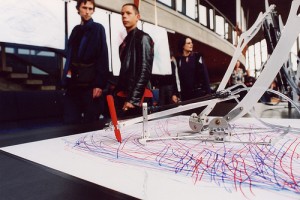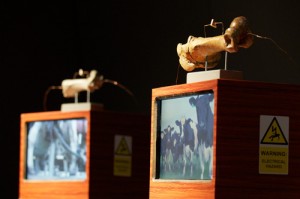A*STAR’s Institute of Bioengineering and Nanotechnology (IBN), located in Singapore, has announced a new platform for testing drug applications. From the April 4, 2012 news item on Nanowerk,
A cheaper, faster and more efficient platform for preclinical drug discovery applications has been invented by scientists at the Institute of Bioengineering and Nanotechnology (IBN), the world’s first bioengineering and nanotechnology research institute. Called ‘Fish and Chips’, the novel multi-channel microfluidic perfusion platform can grow and monitor the development of various tissues and organs inside zebrafish embryos for drug toxicity testing. This research, published recently in Lab on a Chip (“Fish and Chips: a microfluidic perfusion platform for monitoring zebrafish development”) …
From the IBN April 4, 2012 media release,
The conventional way of visualizing tissues and organs in embryos is a laborious process, which includes first mounting the embryos in a viscous medium such as gel, and then manually orienting the embryos using fine needles. The embryos also need to be anesthetized to restrict their motion and a drop of saline needs to be continuously applied to prevent the embryos from drying. These additional precautions could further complicate the drug testing results.
The IBN ‘Fish and Chips’ has been designed for dynamic long-term culturing and live imaging of the zebrafish embryos. The microfluidic platform comprises three parts: 1) a row of eight fish tanks, in which the embryos are placed and covered with an oxygen permeable membrane, 2) a fluidic concentration gradient generator to dispense the growth medium and drugs, and 3) eight output channels for the removal of the waste products (see Image 2). The novelty of the ‘Fish and Chips’ lies in its unique diagonal flow architecture, which allows the embryos to be continually submerged in a uniform and consistent flow of growth medium and drugs (…), and the attached gradient generator, which can dispense different concentrations of drugs to eight different embryos at the same time for dose-dependent drug studies.
…
Professor Hanry Yu, IBN Group Leader, who led the research efforts at IBN, said, “Toxicity is a major cause of drug failures in clinical trials and our novel ‘Fish and Chips’ device can be used as the first step in drug screening during the preclinical phase to complement existing animal models and improve toxicity testing. The design of our platform can also be modified to accommodate more zebrafish embryos, as well as the embryos of other animal models. Our next step will involve investigating cardiotoxicity and hepatoxicity on the chip.”
As a pragmatist I realize that, to date, we have no substitute for testing drugs on animals prior to clinical human trials so this ‘type of platform’ is necessary but it always gives me pause. Just as the relationship between human and animals did the first time I came across a ‘Fish and Chips’ project in the context of a performance at the 2001 Ars Electronica event in Linz, Austria. As I recall Fish and Chips was made up fish neurons grown on silicon chips then hooked up to hardware and software to create a performance both visual and auditory.
Here’s an image of the 2001 Fish and Chips performance at Ars Electronica,
You can find a full size version of the image here on Flickr along with the Creative Commons Licence.
The Fish and Chips performance was developed at SymbioticA (University of Western Australia). From SymbioticA’s Research page,
SymbioticA is a research facility dedicated to artistic inquiry into knowledge and technology in the life sciences.
Our research embodies:
- identifying and developing new materials and subjects for artistic manipulation
- researching strategies and implications of presenting living-art in different contexts
- developing technologies and protocols as artistic tool kits.
Having access to scientific laboratories and tools, SymbioticA is in a unique position to offer these resources for artistic research. Therefore, SymbioticA encourages and favours research projects that involve hands on development of technical skills and the use of scientific tools.
The research undertaken at SymbioticA is speculative in nature. SymbioticA strives to support non-utilitarian, curiosity based and philosophically motivated research.
They list six research areas:
- Art and biology
- Art and ecology
- Bioethics
- Neuroscience
- Tissue engineering
- Sleep science
SymbioticA’s Fish and Chips project has since been retitled MEART, from the SymbioticA Research Group (SARG) page,
Meart – The semi-living artist
The project was originally entitled Fish and Chips and later evolved into MEART – the semi living artist. The project is by the SymbioticA Research group in collaboration with the Potter Lab.
The Potter Lab or Potter Group is located at the Georgia (US) Institute of Technology. Here’s some more information about MEART from the Potter Group MEART page,
The Semi living artist
Its ‘brain’ of dissociated rat neurons is cultured on an MEA in our lab in Atlanta while the geographically detached ‘body’ lives in Perth. The body itself is a set of pneumatically actuated robotic arms moving pens on a piece of paper …
A camera located above the workspace captures the progress of drawings created by the neurally-controlled movement of the arms. The visual data then instructed stimulation frequencies for the 60 electrodes on the MEA.
…
The brain and body talk through the internet over TCP/IP in real time providing closed loop communication for a neurally controlled ‘semi-living artist’. We see this as a medium from which to address various scientific, philosophical, and artistic questions.
Getting back to SymbioticA, my most recent mention of them was in a Dec. 28, 2011 posting about Boo Chapple’s (resident at SymbioticA) Transjuicer installation at Dublin’s Science Gallery (I’ve excerpted a portion of an interview with Chapple where she describes what she’s doing),
I’m not sure that Transjuicer is so much about science as it is about belief, the economy of human-animal relations, and the politics of material transformation.
On that note I leave you with these fish and chips (from the Wikipedia essay about the menu item Fish and Chips),


